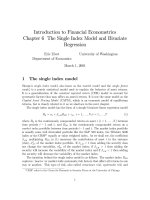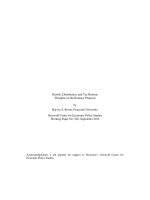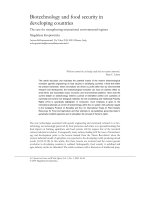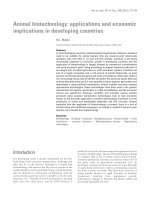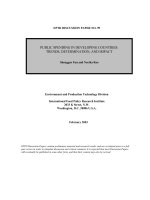Chapter 22 Developing Countries: Growth, Crisis, and Reform
Bạn đang xem bản rút gọn của tài liệu. Xem và tải ngay bản đầy đủ của tài liệu tại đây (1.08 MB, 75 trang )
Chapter 22
Developing
Countries:
Growth, Crisis,
and Reform
Slides prepared by Thomas Bishop
Preview
• Snapshots of rich and poor countries
• Characteristics of poor countries
• Borrowing and debt in developing economies
• The problem of “original sin”
• Types of financial capital
• Latin American, East Asian and Russian crises
• Currency boards and dollarization
• Lessons from crises and potential reforms
• Geography’s and human capital’s role in poverty
Copyright © 2006 Pearson Addison-Wesley. All rights reserved.
22-2
Rich and Poor
Indicators of Economic Welfare for 4 groups of countries, 2003
GNP per capita
Life expectancy
(1995 US$)
Low income
450
58
Lower-middle income
1480
69
Upper-middle income
5340
73
High income
28850
78
Source: World Bank, World Development Report 2004/2005
• Low income: most sub-Saharan Africa, India, Pakistan
• Lower-middle income: China, former Soviet Union, Caribbean
• Upper-middle income: Brazil, Mexico, Saudi Arabia, Malaysia,
South Africa, Czech Republic
• High income: US, France, Japan, Singapore, Kuwait
Copyright © 2006 Pearson Addison-Wesley. All rights reserved.
22-3
Rich and Poor (cont.)
• While some previously middle and low income
countries economies have grown faster than
high income countries, and thus have “caught
up” with high income countries, others have
languished.
The income levels of high income countries and
some middle income and low income countries
have converged.
But the some of the poorest countries have had
the lowest growth rates.
Copyright © 2006 Pearson Addison-Wesley. All rights reserved.
22-4
Rich and Poor (cont.)
GDP per capita
Country
1960
(1996 US $)
2000
annual growth rate
1960-2000 average
United States
12414
33308
2.5
Canada
10419
26922
2.4
Hong Kong
3047
26703
5.6
Ireland
5208
26379
4.1
Singapore
2280
24939
6.9
Japan
4657
24672
4.3
Sweden
10112
23662
2.1
France
7860
22371
2.6
United Kingdom
9682
22188
2.1
Italy
6817
21794
2.9
Spain
4693
18054
3.4
Taiwan
1468
17056
6.7
South Korea
1571
15881
6.0
Argentina
7395
10995
1.0
Copyright © 2006 Pearson Addison-Wesley. All rights reserved.
22-5
Rich and Poor (cont.)
GDP per capita
Country
1960
(1996 US $)
annual growth rate
2000
1960-2000 average
Malaysia
2147
9937
3.9
Chile
3818
9920
2.4
Mexico
3970
8766
2.0
Brazil
2395
7185
2.8
Thailand
1121
6857
4.6
Venezuela
7751
6420
-0.5
Colombia
2525
5380
1.9
Paraguay
2437
4682
1.6
Peru
3118
4583
1.0
685
3747
4.3
1833
1622
-0.3
Ghana
832
1349
1.2
Kenya
780
1244
1.2
Nigeria
1035
713
-0.9
China
Senegal
Source: Alan Heston, Robert Summers and Bettina Aten, Penn World Table Version 6.1
22-6
Rich and Poor (cont.)
Poor countries have not grown faster:
growth rates relative to per capita GDP in 1960
Copyright © 2006 Pearson Addison-Wesley. All rights reserved.
22-7
Characteristics of Poor Countries
•
•
What causes poverty?
A difficult question, but low income countries have at
least some of following characteristics, which could
contribute to poverty:
1. Government control of the economy
Restrictions on trade
Direct control of production in industries and a high level
of government purchases relative to GNP
Direct control of financial transactions
Reduced competition reduces innovation; lack of market
prices prevents efficient allocation of resources.
Copyright © 2006 Pearson Addison-Wesley. All rights reserved.
22-8
Characteristics of Poor Countries (cont.)
2. Unsustainable macroeconomic polices which cause
high inflation and unstable output and employment
If governments can not pay for debts through taxes, they
can print money to finance debts.
Seignoirage is paying for real goods and services by
printing money.
Seignoirage generally leads to high inflation.
High inflation reduces the real value of debt that the
government has to repay and acts as a “tax” on lenders.
High and variable inflation is costly to society; unstable
output and employment is also costly.
Copyright © 2006 Pearson Addison-Wesley. All rights reserved.
22-9
Characteristics of Poor Countries (cont.)
3. Lack of financial markets that allow transfer of funds
from savers to borrowers
4. Weak enforcement of economic laws and
regulations
Weak enforcement of property rights makes investors less
willing to engage in investment activities and makes savers
less willing to lend to investors/borrowers.
Weak enforcement of bankruptcy laws and loan contracts
makes savers less willing to lend to borrowers/investors.
Weak enforcement of tax laws makes collection of tax
revenues more difficult, making seignoirage necessary (see
2) and makes tax evasion a problem (see 5).
Copyright © 2006 Pearson Addison-Wesley. All rights reserved.
22-10
Characteristics of Poor Countries (cont.)
Weak of enforcement of banking and financial regulations
(e.g., lack of examinations, asset restrictions, capital
requirements) causes banks and firms to engage in risky or
even fraudulent activities and makes savers less willing to
lend to these institutions.
A lack of monitoring causes a lack of transparency
(a lack of information).
Moral hazard: a hazard that a borrower (e.g., bank or
firm) will engage in activities that are undesirable
(e.g., risky investment, fraudulent activities) from the less
informed lender’s point of view.
Copyright © 2006 Pearson Addison-Wesley. All rights reserved.
22-11
Characteristics of Poor Countries (cont.)
5. A large underground economy relative to official
GDP and a large amount of corruption
Because of government control of the economy (see 1)
and weak enforcement of economic laws and regulations
(see 4), underground economies and corruption flourish.
6. Low measures of literacy, numeracy, and other
measures of education and training: low levels of
human capital
Human capital makes workers more productive.
Copyright © 2006 Pearson Addison-Wesley. All rights reserved.
22-12
Characteristics
of Poor
Countries
(cont.)
Copyright © 2006 Pearson Addison-Wesley. All rights reserved.
22-13
Borrowing and Debt
in Developing Economies
• Another common characteristic for many middle
income and low income countries is that they have
borrowed extensively from foreign countries.
Financial capital flows from foreign countries are able to
finance investment projects, eventually leading to higher
production and consumption.
But some investment projects fail and other borrowed funds
are used primarily for consumption purposes.
Some countries have defaulted on their foreign debts when
the domestic economy stagnated or during financial crises.
Copyright © 2006 Pearson Addison-Wesley. All rights reserved.
22-14
Borrowing and Debt
in Developing Economies (cont.)
• national saving – investment = the current account
where the current account is approximately equal to the
value of exports minus the value of imports
• Countries with national saving less than domestic
investment will have a financial capital inflows and
negative current account (a trade deficit).
Copyright © 2006 Pearson Addison-Wesley. All rights reserved.
22-15
Borrowing and Debt
in Developing Economies (cont.)
Current account balances of major oil exporters,
other developing countries and high income
countries, 1973-2003 in billions of US$
Major oil
exporters
Other developing
countries
High income
countries
1973-1981
363.8
-410.0
7.3
1982-1989
-135.3
-159.2
-361.1
1990-1997
-73.9
-600.1
79.0
1998-2003
236.5
-12.8
-1344.3
Source: IMF, World Economic Outlook, various issues
Copyright © 2006 Pearson Addison-Wesley. All rights reserved.
22-16
Borrowing and Debt
in Developing Economies (cont.)
A financial crisis may involve
1. a debt crisis: an inability to repay government debt
or private sector debt.
2. a balance of payments crisis under a fixed
exchange rate system.
3. a banking crisis: bankruptcy and other problems for
private sector banks.
Copyright © 2006 Pearson Addison-Wesley. All rights reserved.
22-17
Borrowing and Debt
in Developing Economies (cont.)
• A debt crisis in which governments default on
their debt can be a self-fulfilling mechanism.
Fear of default reduces financial capital inflows
and increases financial capital outflows (capital
flight), decreasing investment and increasing
interest rates, leading to low aggregate demand,
output and income.
Financial capital outflows must be matched with an
increase in net exports or a decrease in official
international reserves in order to pay people who
desire foreign funds.
Copyright © 2006 Pearson Addison-Wesley. All rights reserved.
22-18
Borrowing and Debt
in Developing Economies (cont.)
Otherwise, the country can not afford to pay
people who want to remove their funds from the
domestic economy.
The domestic government may have no choice but
to default on its sovereign debt when it comes due
and investors are unwilling to re-invest.
Copyright © 2006 Pearson Addison-Wesley. All rights reserved.
22-19
Borrowing and Debt
in Developing Economies (cont.)
• In general, a debt crisis causes low income
and high interest rates, which makes
sovereign (government) and private sector
debt even harder to repay.
High interest rates cause high interest payments
for both the government and the private sector.
Low income causes low tax revenue for the
government.
Low income makes private loans harder to repay:
the default rate for private banks increases, which
may lead to increased bankruptcy.
Copyright © 2006 Pearson Addison-Wesley. All rights reserved.
22-20
Borrowing and Debt
in Developing Economies (cont.)
• If the central bank tries to fix the exchange rate, a
balance of payment crisis may result with a debt crisis.
Official international reserves may quickly be depleted, forcing
the central bank to abandon the fixed exchange rate.
• A banking crisis may result with a debt crisis.
High default rates may increase bankruptcy.
If depositors fear bankruptcy due to possible devaluation of
the currency or default on government debt (assets for banks),
then they will quickly withdraw funds (and possibly purchase
foreign assets), leading to bankruptcy.
Copyright © 2006 Pearson Addison-Wesley. All rights reserved.
22-21
Borrowing and Debt
in Developing Economies (cont.)
• A debt crisis, a balance of payments crisis
and a banking crisis can occur together, and
each can make the other worse.
Each can cause aggregate demand, output and
employment to fall (further).
• If people expect a default on sovereign debt,
a currency devaluation, or bankruptcy of
private banks, each can occur, and each can
lead to another.
Copyright © 2006 Pearson Addison-Wesley. All rights reserved.
22-22
The Problem of “Original Sin”
• When developing economies borrow in international
financial capital markets, the debt is almost always
denominated in US$, yen, euros: “original sin”.
• The debt of the US, Japan and European
countries is also mostly denominated in their
respective currencies.
• When a depreciation of domestic currencies occurs
in the US, Japan or European countries, liabilities
(debt) which are denominated in domestic currencies
do not increase, but the value of foreign assets
does increase.
A devaluation of the domestic currency causes an increase in
net foreign wealth.
Copyright © 2006 Pearson Addison-Wesley. All rights reserved.
22-23
The Problem of “Original Sin” (cont.)
• When a depreciation/devaluation of domestic
currencies occurs in developing economies,
the value of their liabilities (debt) rises
because their liabilities are denominated in
foreign currencies.
A fall in demand for domestic products causes a
depreciation/devaluation of the domestic currency
and causes a decrease in net foreign wealth if
assets are denominated in domestic currencies.
A situation of “negative insurance” against a fall in
aggregate demand.
Copyright © 2006 Pearson Addison-Wesley. All rights reserved.
22-24
Types of Financial Capital
1. Bond finance: government or commercial
bonds are sold to private foreign citizens.
2. Bank finance: commercial banks lend to
foreign governments or foreign businesses.
3. Official lending: the World Bank or
Inter-American Development Bank or other
official agencies lend to governments.
Sometimes these loans are made on a
“concessional” or favorable basis, in which the
interest rate is low.
Copyright © 2006 Pearson Addison-Wesley. All rights reserved.
22-25


